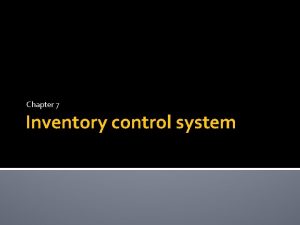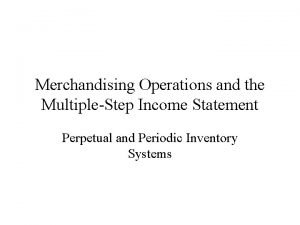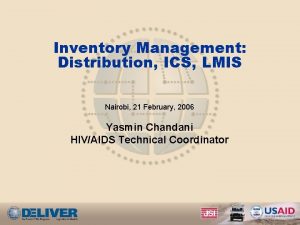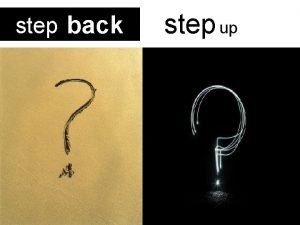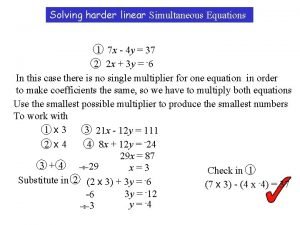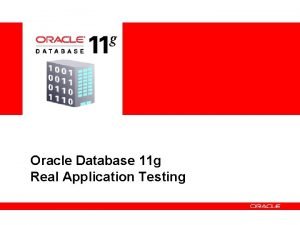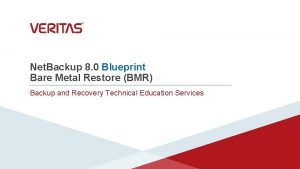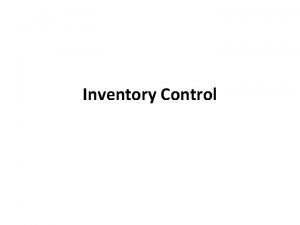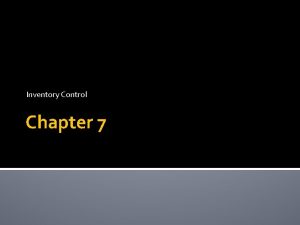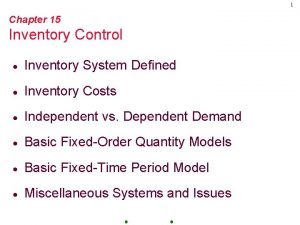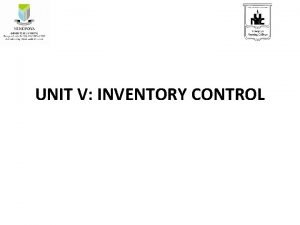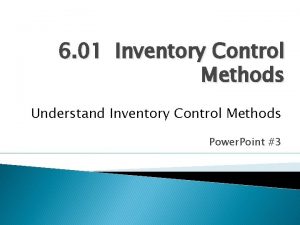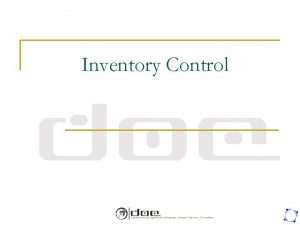Chapter 7 Inventory control system 5 step inventory



















- Slides: 19

Chapter 7 Inventory control system

5 step inventory control system �Step-1: Inventory Planning �Step-2: Establish Order Cycles �Step-3: Balance Inventory Levels �Step-4: Review Stocks �Step-5: Follow-up and Control This system will allow to think systematically thorough the process and assist the business to make the most efficient use possible of the resources represented.

STEP 1: Inventory Planning �Inventory control requires inventory planning. � Inventory refers to more than the goods on hand in the retail operation, service business, or manufacturing facility. �It also represents goods that must be in transit for arrival after the goods in the store or plant are sold or used. � An ideal inventory control system would arrange for the arrival of new goods at the same moment the last item has been sold or used.

Inventory Planning The economic order quantity, or base orders, depends upon �The amount of cash (or credit) available to invest in inventories �The number of units that qualify for a quantity discount from the manufacturer �The amount of time goods spend in shipment.

STEP 2: Establish Order Cycles �If demand can be predicted for the product or if demand can be measured on a regular basis, regular ordering quantities can be setup that take into consideration the most economic relationships among the costs of preparing an order, the aggregate shipping costs, and the economic order cost. �When demand is regular, it is possible to program regular ordering levels so that stockouts will be avoided and costs will be minimized

�If it is known that every so many weeks or months a certain quantity of goods will be sold at a steady pace, then replacements should be scheduled to arrive with equal regularity. �Time should be spent developing a system tailored to the needs of each business. It is useful to focus on items whose costs justify such control, recognizing that in some cases control efforts may cost more the items worth. At the same time, it is also necessary to include low return items that are critical to the overall sales effort.

Seasonal Cycles � If the business experiences seasonal cycles, it is important to recognize the demands that will be placed on suppliers as well as other sellers. � A given firm must recognize that if it begins to run out of product in the middle of a busy season, other sellers are also beginning to run out and are looking for more goods. The problem is compounded in that the producer may have already switched over to next season’s production and so is not interested in (or probably even capable of) filling any further orders for the current selling season.

� Production resources are likely to already be allocated to filling orders for the next selling season. Changes in this momentum would be extremely costly for both the supplier and the customer. � On the other hand, because suppliers have problems with inventory control, just as sellers do, they may be interested in making deals to induce customers to purchase inventories offseason, usually at substantial savings. They want to shift the carrying costs of purchase and storage from the seller to the buyer. � Thus, there are seasonal implications to inventory control as well, both positive and negative. The point is that these seasonable implications must be built into the planning process in order to support an effective inventory management system.

STEP 3: Balance Inventory Levels �Efficient or inefficient management of merchandise inventory by a firm is a major factor between healthy profits and operating at a loss. There are both market-related and budget-related issues that must be dealt with in terms of coming up with an ideal inventory balance:

Balance Inventory Levels � Is the inventory correct for the market being served? � Does the inventory have the proper turnover? � What is the ideal inventory for a typical retailer or wholesaler in this business? �To answer the last question first, the ideal inventory is the inventory that does not lose profitable sales and can still justify the investment in each part of its whole.

Balance Inventory Levels � An inventory that is not compatible with the firm’s market will lose profitable sales. � Customers who cannot find the items they desire in one store or from one supplier are forced to go to a competitor. � Customer will be especially irritated if the item out of stock is one they would normally expect to find from such a supplier. � Repeated experiences of this type will motivate customers to become regular customers of competitors

STEP 4: Review Stocks �Items sitting on the shelf as obsolete inventory are simply dead capital. Keeping inventory up to date and devoid of obsolete merchandise is another critical aspect of good inventory control.

�This is particularly important with style merchandise, but it is important with any merchandise that is turning at a lower rate than the average stock turns for that particular business. �One of the important principles newer sellers frequently find difficult is the need to mark down merchandise that is not moving well.

�Markups are usually highest when a new style first comes out. As the style fades, efficient sellers gradually begin to mark it down to avoid being stuck with large inventories, thus keeping inventory capital working. They will begin to � mark down their inventory � take less gross margin � return the funds to working capital � rather than have their investment stand on the shelves as obsolete merchandise.

Markdowns are an important part of the working capital cycle. Margins on markdown sales are lower, turning these items into cash allows �To purchase current goods �Where companies can make the desired margin

�Keeping an inventory fresh and up to date requires constant attention by any organization, large or small. �Style merchandise should be disposed of before the style fades. �Fad merchandise must have its inventory levels kept in line with the passing fancy. � Obsolete merchandise usually must be sold at less than normal markup or even as loss leaders where it is priced more competitively.

�Loss leader pricing strategies can also serve to attract more‘ consumer traffic for the business �Thus creating opportunities to sell other merchandise as well as the obsolete items. �Technologically obsolete merchandise should normally be removed from inventory at any cost.

STEP 5: Follow-up and Control � Periodic reviews of the inventory to detect slow- moving or obsolete stock and to identify fast sellers are essential for proper inventory management. � Taking regular and periodic inventories must be more than just totaling the costs. Any clerk can do the work of recording an inventory. � However, it is the responsibility of key management to study the figures and review the items themselves in order to make correct decisions about the disposal, replacement, or discontinuance of different segments of the inventory base.

�Inventory quantities must be organized and measured carefully. �Minimum stocks must be assured to prevent stock-outs or the lack of product. � At the same time, they must be balanced against excessive inventory because of carrying costs. �Caution and periodic review of reorder points and quantities are a must. � Individual market size of some products can change suddenly and corrections should be made.
 Step 1 step 2 step 3 step 4
Step 1 step 2 step 3 step 4 Step-by step inventory process
Step-by step inventory process Chapter 15 musculoskeletal system step by step
Chapter 15 musculoskeletal system step by step Perpetual income statement
Perpetual income statement Eyeball system inventory control
Eyeball system inventory control Control inventory meaning
Control inventory meaning Ics inventory control system
Ics inventory control system Teeth disking
Teeth disking Dino the dinosaur text structure
Dino the dinosaur text structure Informative essay outline
Informative essay outline Steps to writing an argumentative essay
Steps to writing an argumentative essay Step back step up
Step back step up How to factor equations
How to factor equations Hardest simultaneous equations
Hardest simultaneous equations Simultaneous equations step by step
Simultaneous equations step by step Combining like terms steps
Combining like terms steps Steps in photosynthesis
Steps in photosynthesis Particle filter matlab code
Particle filter matlab code Oracle real application testing step by step
Oracle real application testing step by step Bare metal restore netbackup
Bare metal restore netbackup

